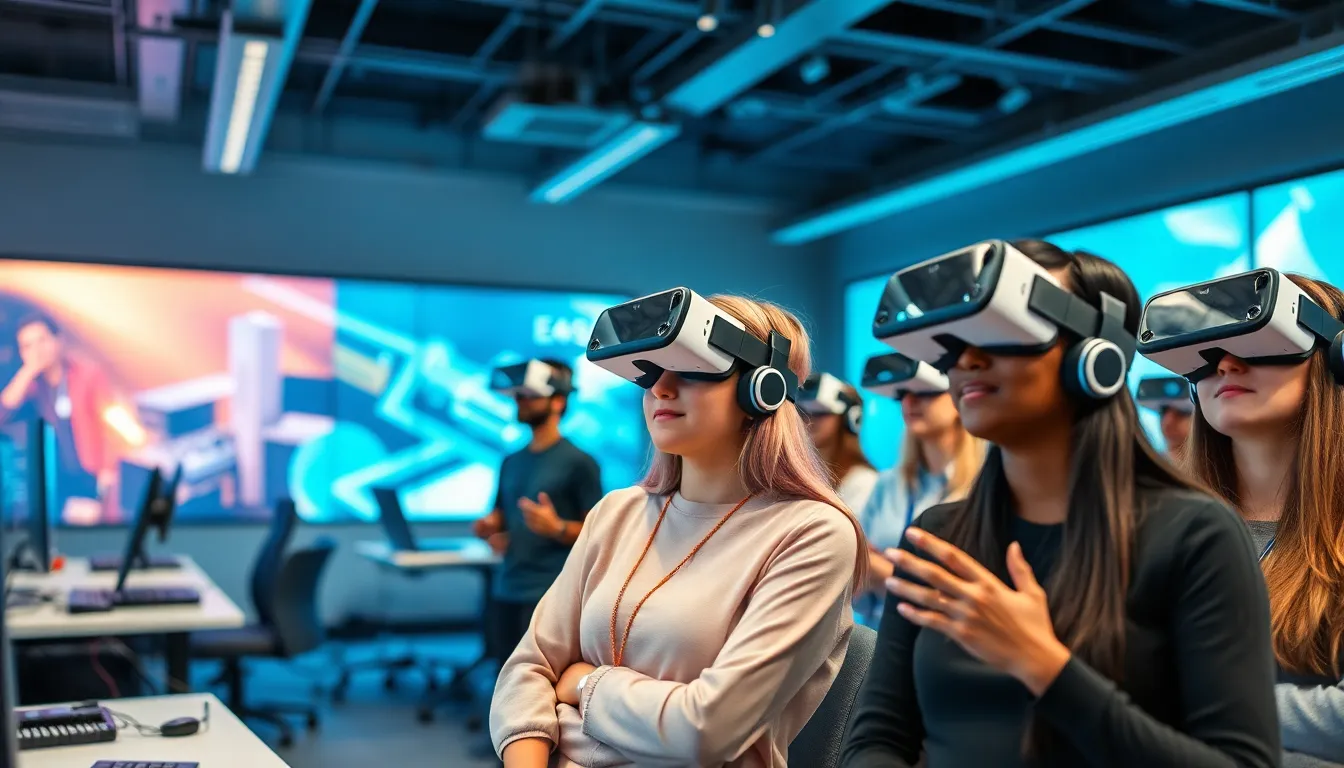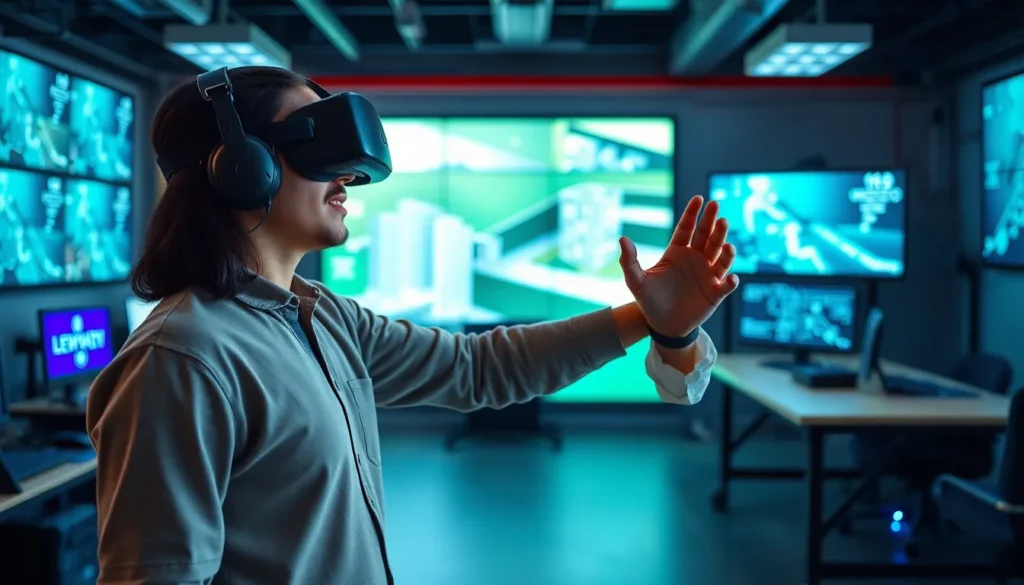Table of Contents
ToggleVirtual reality (VR) is transforming the way people interact with technology and the world around them. From immersive gaming experiences to innovative training simulations, VR is reshaping industries and opening new avenues for creativity and learning. As this technology continues to evolve, understanding how to learn and leverage VR becomes essential for anyone looking to stay ahead in today’s digital landscape.
Learning VR isn’t just for tech enthusiasts or game developers; it’s for anyone interested in enhancing their skills or exploring new possibilities. With user-friendly platforms and a wealth of resources available, diving into the world of VR has never been easier. Whether it’s through online courses, tutorials, or hands-on projects, the journey into virtual reality offers endless opportunities for growth and discovery.
What Is VR Learning?
VR learning refers to educational experiences utilizing virtual reality technology to immerse learners in interactive environments. This innovative approach enables students to engage with content on a deeper level through realistic simulations and hands-on activities.
Key aspects of VR learning include:
- Immersion: Learners experience environments that mimic real-life scenarios, promoting enhanced retention and understanding of complex concepts.
- Interactivity: VR learning encourages active participation, allowing users to manipulate virtual objects and environments to observe outcomes.
- Accessibility: Through VR platforms, education becomes widely available, enabling access to resources previously limited by location or availability.
- Diverse Applications: VR learning applies to various fields, such as medicine, engineering, and history, offering tailored experiences that suit different learning requirements.
Many educational institutions and organizations are adopting VR learning solutions to accommodate diverse learning styles. With its potential to revolutionize traditional education methods, VR learning stands as a valuable tool for personal and professional development.
Benefits of Learning VR

Learning VR presents numerous advantages that enhance both educational experiences and professional development. Below are key benefits associated with mastering this technology.
Enhanced Engagement
Enhanced engagement occurs when learners interact with material in immersive environments. Virtual reality captivates users’ attention, allowing them to explore content actively rather than passively. Users experience a higher retention rate of information, up to 75%, compared to traditional methods, as they participate in scenarios that encourage exploration and problem-solving. Additionally, gamified elements in VR training further boost motivation and excitement, transforming learning into an interactive experience.
Real-World Simulations
Real-world simulations represent another significant advantage of VR learning. Users engage in realistic scenarios without the risks or costs associated with real-life training. For instance, medical students can practice surgeries in a controlled virtual environment, gaining critical hands-on experience. Industries such as aviation, where simulation-based training is crucial, utilize VR to prepare pilots for various flight conditions. These simulations allow learners to apply theoretical knowledge in practical situations, leading to improved skill acquisition and confidence in their abilities.
Tools and Platforms to Learn VR
Various tools and platforms offer opportunities to learn virtual reality effectively. These resources encompass software and hardware essential for VR development and immersive learning experiences.
Software Options
Numerous software options provide essential tools for creating and experiencing virtual reality. Popular choices include:
- Unity: A leading game development platform that supports VR content creation. It offers a robust asset store and extensive documentation for beginners and advanced users alike.
- Unreal Engine: Known for its high-fidelity graphics, Unreal Engine enables developers to build visually stunning VR experiences. It uses Blueprints, a visual scripting language, which simplifies coding for new users.
- Blender: An open-source 3D modeling tool that supports VR content creation. It provides features for modeling, animation, and rendering, making it suitable for artists and developers.
- A-Frame: A web framework for building VR experiences using HTML. It simplifies VR development for web browsers, enabling easy sharing and accessibility.
- Vive Sync: A collaboration tool designed for VR meetings and interactions. It provides immersive spaces for team collaboration, benefiting remote work and educational settings.
Hardware Requirements
Learning VR requires specific hardware to ensure optimal performance. Key hardware components include:
- VR Headsets: Devices like the Oculus Quest 2, HTC Vive, and Valve Index deliver immersive experiences. These vary in price, performance, and features, with standalone and tethered options available.
- Powerful PC: A VR-ready computer with a high-performance graphics card (e.g., NVIDIA GeForce RTX series) is essential for running demanding VR applications. The recommended specifications typically include Intel i5/i7 processors and at least 16GB of RAM.
- Controllers: Handheld motion controllers enhance interactivity within VR environments. These devices track user movements, allowing for more engaging experiences.
- Tracking Sensors: External sensors can improve positional tracking accuracy, enhancing the overall user experience. Options vary by headset but may involve base stations or inside-out tracking systems.
Utilizing the right tools and hardware streamlines the VR learning process and empowers users to create and engage with immersive content effectively.
Steps to Get Started with VR Learning
Embarking on a VR learning journey requires careful consideration of available resources and practical experience. The following steps outline how to effectively initiate this process.
Choosing the Right Course
Selecting the appropriate course is crucial for effective VR learning. Various online platforms like Coursera, Udacity, and LinkedIn Learning offer structured courses tailored for different skill levels. Each course typically covers essential topics, including 3D modeling, coding in VR environments, and interaction design. It’s important to review course content and prerequisites to ensure alignment with career goals. Reading reviews and joining community forums can also provide insights into course effectiveness and relevance.
Practicing with VR Scenarios
Practicing with realistic VR scenarios enhances skill retention and application. Many platforms provide simulations that mirror real-world challenges in fields such as healthcare or engineering. Engaging in hands-on projects enables learners to apply theoretical knowledge in a controlled setting. Creating personal projects using tools like Unity or Unreal Engine allows for experimentation with design and interactivity elements. Regular practice through these scenarios solidifies understanding and prepares individuals for real-life applications within their industries.
Embracing virtual reality is essential for anyone aiming to thrive in today’s digital landscape. The immersive and interactive nature of VR learning not only enhances engagement but also prepares individuals for real-world applications across various industries.
With a plethora of resources and platforms available, the journey into VR can be both accessible and rewarding. By leveraging the right tools and engaging in hands-on projects, learners can unlock new opportunities and elevate their skills.
As VR continues to evolve, those who invest time in understanding and utilizing this technology will undoubtedly find themselves at the forefront of innovation and professional growth.




